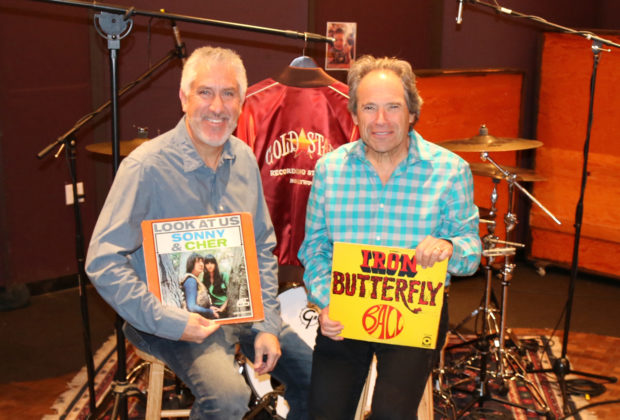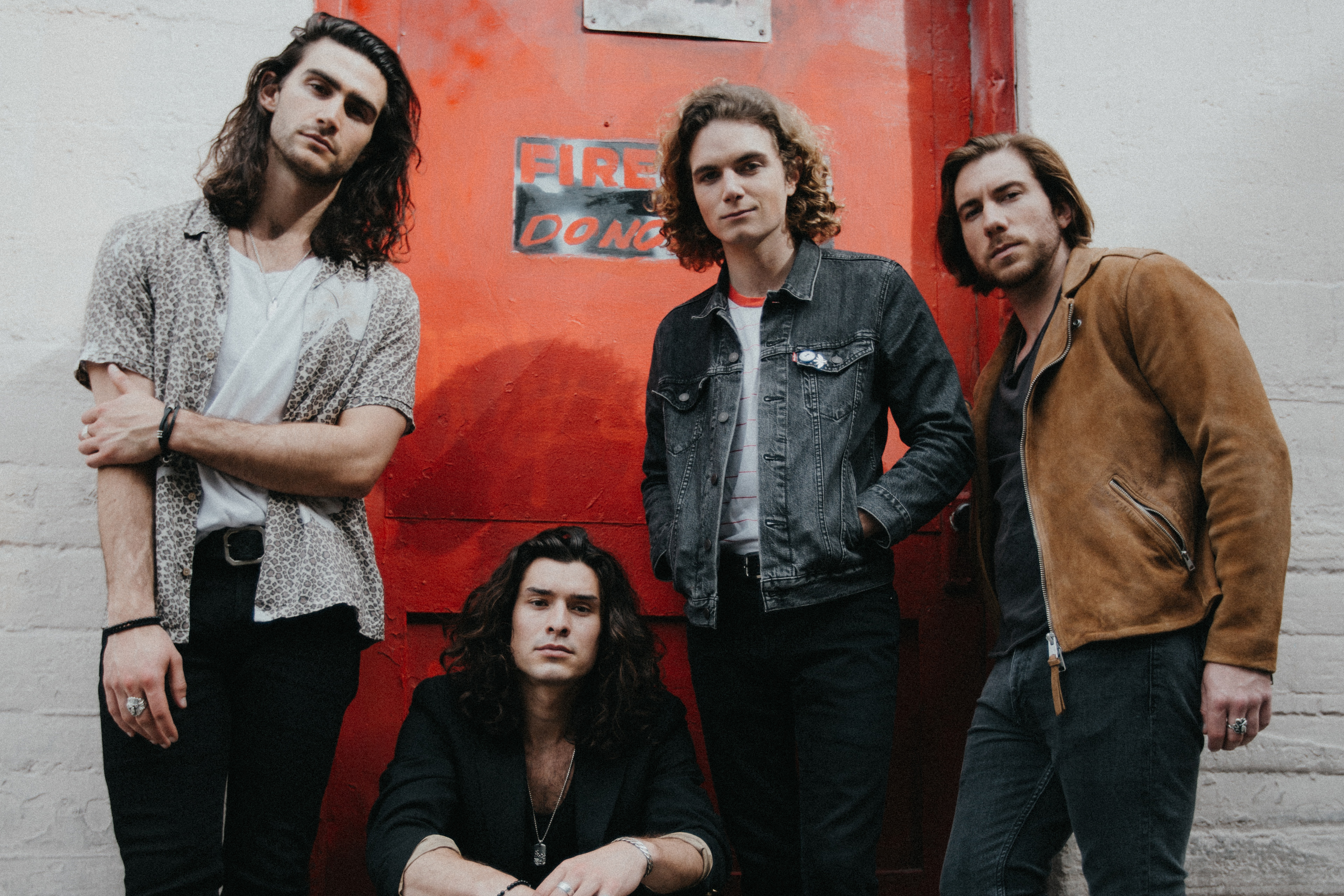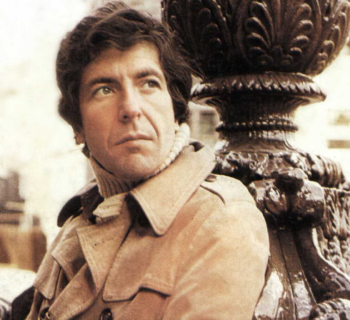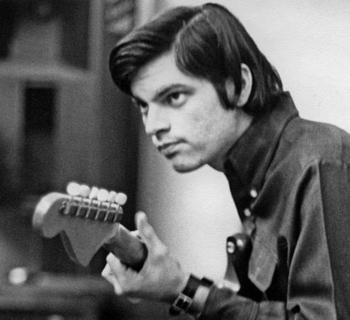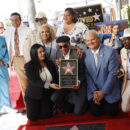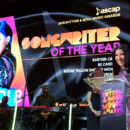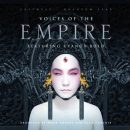San Diego Repertory Theatre (San Diego REP) announced that they will be partnering with the San Diego School of Creative and Performing Arts (SDSCPA) and R & R Productions, LLC for the world premiere musical 33 1/3 - House of Dreams. Written by local San Diegans Jonathan Rosenberg and Brad Ross, with additional contributions by Steve Gunderson and Javier Velasco, the debut production chronicles the success of Gold Star Recording Studios through the history of rock ‘n’ roll.
The production will feature direction and choreography by Javier Velasco with musical direction and arrangements by Steve Gunderson. 33 1/3 - House of Dreams will run Aug. 1-25, at San Diego REP’s Lyceum Stage Theatre, with previews on Aug. 1 - 6, and a press opening on Wednesday, Aug. 7 at 7:00 p.m.
33 1/3 - House of Dreams tells the story of the legendary Gold Star Recording Studios and its co-founder, lead engineer and hitmaker Stan Ross. In Hollywood for 33 1/3 years, Gold Star was the birthplace of some of the greatest pop and rock hits of all time. Imagine a story featuring the music of a young Phil Spector and his Wall of Sound, The Beach Boys, Eddie Cochran, Sonny and Cher, Ike & Tina Turner, The Righteous Brothers, Ritchie Valens and many, many more.
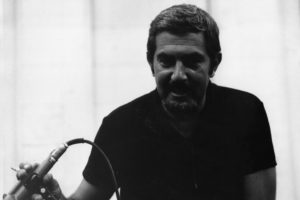
Stan Ross
The show’s 30-song playlist includes rock ‘n’ roll classics such as “Summertime Blues,” “La Bamba,” “Good Vibrations,” "Be My Baby," “Unchained Melody,” “Wouldn’t It Be Nice” “In A Gadda Da Vida,” “Tequila,” “Da Doo Run Run,” “River Deep, Mountain High,” “Let’s Dance,” “Rhythm of the Rain,” “He’s a Rebel,” “The In Crowd,” “Grazin’ In The Grass” and “Rockin’ Robin.”
“The creation of 33 1/3 - House of Dreams is the culmination of efforts to share the story of what happened within the walls of Gold Star Recording Studios,” shared writers and co-creators Jonathan Rosenberg and Brad Ross.
“Our musical is a way for us to honor the hit music and achievements through one of its co-owners, Stan Ross. He was the personality, lead engineer and mentor at Gold Star. His creative pioneering along with his partner's technical knowledge and studio design led them to develop Phil Spector's famous Wall of Sound productions. Stan's story is our story, and is still relevant today.”
Brad Ross is the co-writer of 33 1/3 - House of Dreams and a practicing dentist in San Diego, California. Raised in Burbank, California, the story of 33 1/3 - House of Dreams centers around his father Stan Ross—co-owner and engineer at Gold Star Recording Studios in Hollywood who died at age 82 on March 11, 2011 following an operation to correct an abdominal aneurysm.
Brad participated in interviewing many artists, producers, songwriters, musicians, arrangers, music historians and ex-employees who recorded at Gold Star. His passion for sharing the stories and music of Gold Star inspired Brad to collaborate with his patient, Jonathan Rosenberg to develop this project. Brad is a graduate of Oregon State University and USC School of Dentistry.
“After the death of my father in 2011, I took on the role of creating a production that would tell his life story,” explained Ross. “As a producer and co-writer, I have spent the last 4 years researching and conducting video interviews with artists, songwriters, producers, arrangers, musicians and former employees that were involved in any aspect of Gold Star’s existence as a mecca for the music industry from 1950-1984.
“These interviews have advanced both our projects: a music documentary and a theatrical musical stage play.
“In the play, we follow the path of Stan and his partner David Gold reflecting on the creative events and significant moments that allowed the studio to become one of the most successful independent recording studios in the world. Their creativity was recognized and promoted by Phil Spector in his Wall of Sound productions. He selected Gold Star due to its famous echo chamber and engineering techniques that allowed his unique production style to flourish. Gold Star was a place where any nationality, race, and faith could feel welcome to record and perform their music in a nurturing and welcome environment.
“And to go in that studio, with all the history, and hear our music coming through those speakers, even though it’s a four-track machine, was bigger than life.”
“The play is being directed by San Diego’s Javier Velasco with music direction by Steve Gunderson, both well-known creative resources in the San Diego community.
“Jonathan is a member of The Dramatist organization and is the lead writer/researcher/interviewer on the projects. My role in addition to writing has been to develop relationships with the individuals that were part of Gold Star’s history and to oversee business aspects of R & R Productions, LLC.”
Jonathan Rosenberg is a native of The Bronx. For 30 plus years Rosenberg, in addition to being a psychologist and teacher, has worked as an entertainment writer, radio personality and a lead singer/songwriter. In 2014, he turned his attention to playwriting and broke attendance records at the San Diego Fringe Festival for his musical, Long Way to Midnight.
In the coming months, Jonathan will have two World Premiere musicals opening: 33 1/3 - House of Dreams, and Americano (Phoenix Theatre in Arizona). Jonathan received his bachelor’s from City College in New York, his Master’s from the University of Michigan and his Doctorate from Alliant University in San Diego.
“What amazed me the most about this project was the reverence the music community still has for Stan Ross,” exclaimed Rosenberg. “The fact that Brad was Stan's son opened almost every door we knocked on. Brian Wilson, Bill Medley, Herb Alpert, Richie Furay, Mike Curb and the Wrecking Crew musicians spent time with us recollecting their many great Gold Star memories.
“At that point, we realized that this was a story that has yet to be told. People don't think of Gold Star Recording Studios in the same way they think of Sun Studios, Motown, or Abbey Road. That's all going to change after they see 33 1/3 - House of Dreams.”
“It’s an amazing story and should be told for the younger generation to follow,” volunteered drummer/percussionist Hal Blaine in 2013.
Gold Star garnered more Recording Industry Association of America (RIAA) Songs of the Century and Grammy Hall of Fame winners than any other independent studio in America.
Stan Ross and Dave Gold’s studio clients were: Herb Alpert & The Tijuana Brass, Sonny & Cher, Buffalo Springfield, Neil Young, Jack Nitzsche, Shel Talmy, Brian Wilson with The Beach Boys, Kim Fowley, Barry White, The Cascades, Iron Butterfly, Cher, the Cake, Eddie Cochran, Jerry Capehart, Johnny Crawford, Don Ralke, Jackie DeShannon, Bob Dylan, Clydie King, Don Peake, Art Garfunkel, Dick Dale, Bobby Darin, David Briggs, The Rose Garden, Johnny Burnette, Thee Midniters, The Sunrays, Mark and the Escorts, Jon & The Nightriders and The Dillards.
Tim Hardin, The Beau Brummels, The Murmaids, Led Zeppelin, Ronald Reagan, Hoyt Axton, Robin Ward, George Carlin and Jack Burns, Duane Eddy, The Sonics, Margie Rayburn, Marlon Brando, The Band, The Runaways, The Go-Gos, The Ramones, The Seeds, The Monkees, The MFQ, The Turtles Oscar Moore, Gerry Mulligan, Mundell Lowe, Chet Baker, Louis Bellson’s big swing band and The Hi-Los utilized the famed location.
During 1962, before Marty Balin founded Jefferson Airplane, he and arranger Jimmie Haskell waxed “I Specialize in Love” at the facility. In 1963, Noel Scott Engel, later known as Scott Walker, the revered UK musical icon, was hired for menial tasks and surf/instrumental efforts, and Jimi Hendrix and Arthur Lee in 1965 teamed on Rosa Lee Brooks’ “My Diary” 45 RPM.
Dobie Gray’s “The In Crowd,” arranged by Al De Lory, Chris Montez’s “Let’s Dance” and Jackie DeShannon’s Laurel Canyon were done on the premises. The Gold Star environment yielded Hugh Masekela’s “Grazin’ in the Grass, arranger Gene Page’s Blakula soundtrack and Star Trek’s William Shatner reciting “Lucy In The Sky With Diamonds.”
Stan Ross was behind the console for Jewel Aikens’ “The Birds and The Bees,” the first use of chorused guitar and was a favorite of Rolling Stones’ Brian Jones, which provided the sound of a guitar plugged through a Leslie speaker, giving it an organ-like effect.
At this temple of sound, Don & Dewey’s “Jungle Hop” introduced the electronically distorted guitar while Phil Spector’s production of “Zip A Dee Do Dah” by Bob B. Soxx & The Blue Jeans was the first distorted lead guitar on a hit record.
Gold Star also developed phasing, DT (Double-tracking) and flanging techniques. Gold, Ross and engineer Larry Levine integrated the concept of phase-shifting or “phasing,” a sweeping effect that incorporated electronic music on their hit disc “The Big Hurt” by the vocalist Toni Fisher.
Kit Lambert produced “Call Me Lightning” by The Who at Gold Star and mixed their “I Can See For Miles." Also birthed at this mystical spot was Charles Wright & The Watts 103rd Street Rhythm Band’s “Express Yourself,” Shelby Flint’s “Angel On My Shoulder” and “Endless Sleep” by Jody Reynolds.
Brian Wilson was a regular Gold Star visitor and customer for years. Brian produced The Beach Boys’ “Do You Wanna Dance,” “I Just Wasn't Made For These Times,” which featured the initial usage of the theremin on a pop recording, “Wouldn’t It Be Nice,” and the original version of “Heroes & Villains.” A version of “Cabin/Essence” earmarked for Smile was attempted. Father Murry Wilson did his The Many Moods of Murry Wilson LP there. “Deirdre” and “Slip On Through” on the Beach Boys’ Sunflower, were taped in the historic setting.
“Gold Star felt and sounded different than any other L.A. studio,” disclosed The Turtles’ Howard Kaylan, who recorded “The Story of Rock & Roll" pop gem and other wonderful tunes like “Eleanor” there in addition to their revolutionary The Battle of the Bands produced by Chip Douglas.
“You could literally smell the tubes inside the mixing board as they heated up. There was a richness to the sound that Western and United, our usual studios, never had. Those two rooms sounded ‘clean’ while Gold Star felt fat and funky. Perhaps we were all reading too much of the Spector legacy into the room, but I don't think so. Our recordings from Gold Star always just sounded better to me. I miss that room,” mused Kaylan, whose band The Turtles sold 41 million records and had 9 Top Ten hits of their own.
Cher's first solo hit, “All I Really Want To Do,” written by Bob Dylan, came out of Gold Star, alongside her duo albums with Sony Bono, as well as Sonny’s own outing “Laugh At Me.”
In my 2009 book, Canyon of Dreams: The Magic and the Music of Laurel Canyon, the multi-instrumentalist Randy Sterling described the studio scenario around Cher’s “All I Really Want To Do,” even playing a pivotal role in ensuring it got on tape in the first place.
“We had finished the basic track and, in the hallway that led out to the back alley at Gold Star, Cher was standing there alone with her hands on her hips. She was about to record her lead vocal and was alone. She turned around and almost had tears in her eyes. ‘Oh Randy, I just don’t know if I can do this.’ I gave Cher a big hug and said. ‘Honey, you’re the best. This is nothing. This is easy and it’s your song. And it’s gonna be a big hit.’ I gave her a pep talk. ‘You haven’t sung it yet and I know it’s gonna be a big hit. Get in there and do what you do and it will be fine.’
“She walked back into the studio, did it, and knocked it out of the ballpark in one take. When we were doing it I knew it was good. I hung out with Sonny & Cher a lot when they were based out of Laurel Canyon.”
The Band in 1968 during Music From Big Pink recorded songs at Gold Star, “Key To The Highway” and “Long Distance Operator” after working on Vine Street at Capitol Records’ 8-track machine.
“We were doing some recording at the studio at Capitol Records in Hollywood and it was one thing, but there was such talk about just ‘the vibe’ and ‘the sound’ at this other place, Gold Star,” Robbie Robertson informed me in an interview I conducted with him in 2000.
“We were kind of off the clock, and we were going to record some things that weren’t necessarily going to be on the record, so we thought, ‘let’s just go and check it out.’ I think we were only there one day or two days.”
In every book and story about the life of Phil Spector, Stan Ross is mentioned along with Dave Gold and Larry Levine. They collectively toiled for years in Gold Star, made overt and subtle sound design contributions to Phil Spector’s studio undertakings while jointly constructing the “Wall of Sound.”
In 2015, the legacy of Gold Star was depicted in a documentary, The Wrecking Crew, by filmmaker Denny Tedesco, son of guitarist and studio musician, Tommy Tedesco.
This decade, Brian Wilson, Herb Alpert, Richie Furay, Mike Curb, Chris Montez, Kim Fowley, Nino Tempo, Bill Medley, Carol Connors, Richard Sherman, Donna Loren, Jon Blair, Marky Ramone, Brian Stone, Mark Guerrero, Lyle Ritz, Carol Kaye, Johnette Napolitano, Don Randi, Don Peake, David Kessel, Steven Van Zandt and myself were filmed for the documentary about Gold Star and co-owner/engineer Stan Ross directed it and it was produced by Jonathan Rosenberg and Stan’s son, Brad Ross.
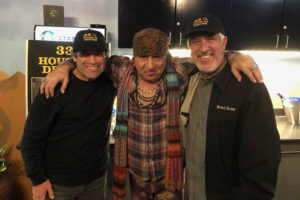
Jonathan Rosenberg, Steven Van Zandt and Brad Ross
Gold Star and Spector were a special destination force—the alchemy of geography, Ross, Gold and Levine’s technical acumen combined with Spector’s stylistic confidence.
"I loved the echo. It's like garlic. You can't get too much."
Dave Gold hails from the Boyle Heights section of East Los Angeles, California.
Ross, born in Brooklyn, New York in 1928, moved with his parents to Los Angeles at age 15. Stan then enrolled at Los Angeles’ acclaimed Fairfax High and graduated in 1946. Stan wrote a music column in the Fairfax Colonial Gazette called Musical Downbeat and his scoops were bannered Off the Record.
When he was a teenager, Ross studied recording from a pioneer of modern disc recording, Bert B. Gottschalk. Stan worked at his Electro-Vox studio for four years as an engineer and was responsible for one hit record, “Deck of Cards” by T. Texas Tyler.
“Gold Star used to be a dentist’s office,” Stan Ross reminded me in a 2001 interview we conducted. “We started pulling teeth a different way.”
Gold Star was built in 1950 and lasted until 1984 at 6252 Santa Monica Blvd until a fire destroyed the property in March 1984.
“Gold Star was built for the songwriters. They were fun, wonderful people to be around: Jimmy Van Heusen, Bobby Troup, Bob and Richard Sherman, Sammy Fain, Sonny Burke, Don Robertson, Johnny Mercer, Jimmy McHugh, Frank Loesser, Dimitri Tiomkin. We did song demos, voice-over work, radio and TV jingles.
“I loved music, and I was a record buyer, and I know what I liked. If I’m going to buy a record, I want it to sound like this. So I made everything I got involved with like something I would buy.
“Our studio echo chamber gave it the wall of sound feel. Dave (Gold) built the equipment and echo chamber and personally hand-crafted the acoustical wall coating. We had so much fun with that echo chamber; it never sounded the same way twice. Gold Star brought a feeling, an emotional feeling.
“The soundboard was all tubes. And when you have tubes, you have expansion and it doesn’t distort so easy. We kept tubes on longer than anyone else because we understood that when a kick drum kicks into a tube it’s not gonna distort. A tube can expand. The microphones with tubes were better than the ones without the tubes because if you don’t have a tube and you hit heavy, suddenly it breaks up. But when you have a tube, it’s warm and emotional. It gets bigger and it expands. It allows for the impulse,” underscored Ross.
“Gold Star brought a feeling, an emotional feeling. I’ve been in other studios that were ‘too hot,’ ‘too lively,’ some that sounded like cardboard boxes. ‘Too dead.’
“Gold Star had enough echo that if you snapped your fingers, or clapped your hands, you could actually hear it. So if that’s the way your hands clapped, then your drum sound would be the same kind of feel. Our echo chamber gave it the ‘Wall of Sound’ feel. It was smaller than most people knew.”
Stan was behind the console for Phil Spector on his 1958 Teddy Bear’s recording, “To Know Him Is To Love Him” and subsequent Spector bookings at Gold Star 1962-1966.
The history and mystery of Gold Star and previous clients in the fifties were not lost on teenage Spector when he knocked on their magical entry door.
“Phil followed in a studio tradition,” reinforced Stan. “We used Studio A. Eddie Cochran used our Studio B. Down the stairs by the parking lot. I cut ‘Tequila’ there by The Champs.
“I did a whole lot of Eddie Cochran’s records including ‘Summertime Blues,’ ‘20 Flight Rock’ and ‘C'mon Everybody.’ The vocal of Ritchie Valens’ ‘Oh Donna’ was recorded at Gold Star. The backing track was done up the street at Bob Keene’s studio who owned Del-Fi Records.”
In a 2010 phone interview from Bogota, Colombia, author, record producer and deejay Andrew earlier commented about Spector/Gold Star.
"In late 1958 'To Know Him Is To Love Him' changed my world. I was 14. I'd loved 'Born Too Late,' 'Silhouettes' and 'Come Softly to Me,' but this was different.
"This was the sound of one man screaming at and embracing his very own version of the world. And he managed to record that sound. And that sound, that feeling and meaning has managed to survive man going to the moon, doing the moonwalk, giving live aid and being born to run.
"Phil Spector wrote, arranged and produced the record, he was just 17. You know what I mean...He made it with Stan Ross and Gold Star and they changed the sound of music. It would never be the same again.”
Previously in 2014, Oldham addressed the Spector/Gold Star pairing during a chat we had.
“I heard the record 'To Know Him Is To Love Him' in the UK. It made an impact because of the use of room, the usage of tape delay. You knew something was going on, even if you didn’t know what it was.
“Later, after I’d recorded the Rolling Stones’ ‘Not Fade Away’—or let’s say ‘Little Red Rooster,’ you realized by recording in similar mono circumstances in London’s Regent Sound as opposed to Gold Star, or wherever Phil did ‘To Know Him Is To Love Him,’ what the room brought to the game.
“There is a lot of magic to ‘To Know Him Is to Love Him.’ Basically, how can anybody resist those backgrounds? It’s a great part for the public to sing along with and be at one with the song. Maybe one of the things that drew me to the record was that there was a subliminal audio text from Eddie Cochran records. Eddie had already recorded ‘Summertime Blues’ at Gold Star. So we didn’t know, but you do know, man. That’s my memory of it.”
In 1964 Oldham produced a cover version of “To Know Him Is To Love Him” by Cleo Sylvestre with musical arranger Mike Leander.
During a 2019 chat, Andrew acknowledged, “The reason I did Cleo with The Teddy Bears song was that it seemed an appropriate homage to a piece of vinyl that had so warmed my life as my first non-Stones release. I knew it would not be a hit. That was not the point. It was a mission statement.”
In 1964, Oldham and his Andrew Loog Oldham Orchestra did a re-make of The Crystals’ “Da Doo Ron Run” with Mick Jagger joining on vocals.
“Da Doo Ron Ron” is spotlighted in 33 1/3- House of Dreams.
“As for ‘Da Doo Ron Ron' by the Orchestra that was done in Mono at Regent Sound aping the Jack Nitzsche version, which I would do better, later, with the currently topical version of ‘The Last Time’ by the Orchestra. The earlier Jagger vocals orchestra version shows us learning on the job. There’s a great moment two minutes or so in where the two overdubbed cellos force the basic track to nearly drop out.”
Leonard Cohen made a remark to me about recording with Spector on his Death Of A Ladies' Man LP in a January 1978 interview published in Los Angeles Phonograph Record Magazine. “Phil is not a great songwriter, but he's a bold one. He's bold enough to employ the most pedestrian melodies, and yet somehow make them absolutely successful. That is why his compositions are brilliant."
Cohen was especially impressed by Spector's early work—"To Know Him Is To Love Him" and "You’ve Lost That Lovin' Feelin'."
Larry Levine, Ross’ cousin, who also attended Fairfax High School, was a house engineer at Gold Star and a crucial component in Spector’s “Wall of Sound” audio endeavors.
Levine won a 1966 Grammy Award for Best Engineered Recording-Non Classical, for his work on “A Taste of Honey” performed by Herb Alpert & The Tijuana Brass.
Larry engineered albums for Eddie Cochran, The Beach Boys, Sonny and Cher, Herb Alpert & the Tijuana Brass, The Carpenters, Dr. John and with Spector in the late '70s albums by Leonard Cohen and The Ramones. He engineered The Ramones’ End Of The Century, with Boris Menart and assisted by Bruce Gold.
“As a matter of fact,” mentioned Levine in a 2002 interview, “Phil once said to me the bane of his recording existence was the drum sound. A lot of people attribute the echo to what Phil was doing. The echo enhanced the melding of the ‘Wall of Sound,’ but it didn’t create it. Within the room itself, all of this was happening and the echo was the glue that kept it together,” offered Larry, who passed away in 2008.
“As far as the room sound and the drum sound went, because the rooms were small, with low ceilings, the drum sound, unlike other studios with isolation, your drums sounded the way you wanted them to sound. They would change accordingly to whatever leakage was involved.
“The best producers are people who know what they want and know how to communicate so that all of us can strive towards their goal, while the producer is still amenable to something else that may happen along the way. In my career, I’ve worked with three great producers—Phil Spector, Herb Alpert and Brian Wilson.”
“The man [Phil Spector] is my hero,” Brian Wilson told me in a 1997 interview. “He gave rock ‘n’ roll just what it needed at the time and obviously influenced us a lot. His productions—they’re so large and emotional…powerful—the Christmas album is still one of my favorites. We’ve done a lot of Phil’s songs: ‘I Can Hear Music,’ ‘Just Once In My Life,’ ‘There’s No Other Like My Baby,’ ‘Chapel Of Love.’ I used to go to his sessions and watch him record. I learned a lot.”
“Let me tell you a story,” Brian Wilson divulged in a 2007 interview. “I went to Gold Star and asked Larry Levine, the engineer, ‘What is the secret of the Phil Spector echo trip?’ And Larry replied, ‘Well, we have two echo chambers under the parking lot. Phil uses both the chambers at the same time.’ So I tried that myself and it worked.
“I also wanted to know from Larry what Phil Spector did with his basses. Larry said, ‘Phil uses a standup and a Fender both at the same time. And the Fender guy used a pick.’
“So I tried it out at my session and it worked great! You also get a thicker sound putting the two basses together. I start with drums, bass, guitar and keyboards. Then we overdub the horns and the background voices.”
Don Randi played piano, keyboards and organ on every Spector-produced and Jack Nitzsche-arranged activity at Gold Star since 1962. In addition, Randi can be heard on the Beach Boys’ album Pet Sounds, Buffalo Springfield Again, Love’s Forever Changes and The ‘68 Elvis Presley Comeback Special. Randi’s resume displays The Birds, The Bees & The Monkees, Tim Buckley’s Goodbye & Hello and chart recordings with both Frank and Nancy Sinatra.
“Gold Star was an incredible place since the first time I ever worked there,” stressed Randi.
“It was friendly. And they always had a good staff there that was friendly. Between Dave Gold, Stan Ross and Larry Levine, and Doc Siegel, it was great and fun. I worked a lot with Stan and Larry. Doc Siegel got destined to do the ‘B’ sides for Phil Spector.
“Everybody playing parts and a lot of time duplication. Like on the pianos, you would have one guy doing a thing on the high end of the piano, somebody in the middle, and Phil would want the different sounds of a concert grand, and an upright, electric or a Wurlitzer. So he liked to have the spread of the different tonality. That was Phil. He understood tonality very well. And at Gold Star it was magic because of all those harmonics rising were part of the wall of sound.
“The studio can make a difference in the sound of a record. At Gold Star, it was the echo chamber. Like, when someone talks about a guy being a ‘natural baseball player,’ Gold Star was a natural studio. It just blended and worked. When you went to Gold Star you just knew you were making a hit record. Jack Nitzsche was a good translator for Phil,” reminisced Randi.
“As far as the music recorded and documented in Gold Star, it was because musically and lyrically and the composition and note part was brilliant. There were always great songs. The songs always told a story. The songs in themselves were films. And, especially in Phil’s case, he knew how to write them and how to produce them. And in Brian Wilson’s case, Brian always knew where he was going with it. He may have not known at the beginning, but after awhile, he had an idea and he developed it. We were there to help him develop it,” Randi reiterated.
One night in 1988 at Musso & Frank Grill, Jack Nitzsche’ favorite restaurant on Hollywood Blvd., I asked Jack how the “Wall of Sound” started.
“It happened over a period of time. I don’t know who coined the term. The sound just got bigger and bigger. One time we cut the Crystals’ ‘Little Girl.’ Sonny Bono was the percussionist on the date. He came into the booth, and said it had more echo than usual, and it wouldn’t get played on the radio. The echo was turned way up high. Phil said,
‘What’s too much echo? What does that mean?’ Phil was smart enough to say, ‘Wait a minute listen to this.’ If you notice, there’s more echo on each song we cut. It hadn’t been done like this before. People on the business side, the promotional side of the record industry, felt it was different. He didn’t listen to them,
“There were four echo chambers, and I remember engineer Stan Ross, who was co-owner with Dave Gold, telling us many times that the echo chambers were acoustically and geometrically designed to get the right amount of balance and reverb. That added to the impact of Phil's recordings. I loved the echo. It's like garlic. You can't get too much. 'What's too much echo?' Phil once said during a session.
“The musicians played at once. Before that, I was working with compact rhythm sections and three or four players. This was groundbreaking for me.
“The vocals would last all night. Background groups doubling and tripling so it would sound like two or three dozen voices. Phil would spend a lot of time with the singers. I would split and he’d still be working on lines with the singers. The rhythm section and the horns were done together. Vocals and string parts were overdubbed later. We did most of the sessions at Gold Star Studios in Hollywood. I loved the rooms, but it was always too small for all the people. Phil was on his game all the time.
“‘Then He Kissed Me’ is my favorite Crystals record. Listen to the percussion! Castanets and all. We had some room to experiment and make records sound different. Phil would go into the percussion kit and say, 'This song needs castanets.’ Everything blended so well.
“'Be My Baby.’ Ronnie Spector’s voice. Wow! I was amazed at her vibrato. It got bigger and bigger with each record. That was her strong point. When that tune was finished, the speakers were turned so high in the booth people had to leave the room. It was loud.
“I arranged the Christmas album. We had a lot of fun. Darlene Love singing ‘Christmas (Baby Please Come Home)’ blew my mind. I got chills. Powerful. She could always sing. Sonny always made everyone laugh. The album never really took off. I think some of that had to do with the world after the Kennedy assassination. It affected the public. No one wanted to celebrate Christmas in December 1963.”
The epic song "River Deep, Mountain High,” written by Jeff Barry, Ellie Greenwich and Spector, and covered by dozens of recording artists was initially arranged by Jack Nitzsche and produced by Spector for Ike & Tina Turner at Gold Star.
"And if they wanted 15 pressing plants to have masters Neil didn’t want prints made up from one master. He wanted Dave Gold to make 15 separate acetates."
“Phil Spector helped write ‘River Deep, Mountain High’ and said, 'I've got a song for Tina,’” Jack Nitzsche told me in a 1988 interview. “I went over to Phil's house and went over the arrangement note by note. When Phil played me it on the piano I knew it was a great song.
“I’ve talked to Gerry Goffin about that a lot; Phil co-writing songs that he would produce. Phil would always have the writers come over and write in the room with him, and I knew he directed it. They all say the same thing; that without Phil Spector in the room that song wouldn’t have been that way. He helped. He knew what he wanted it to be.
“We did the rhythm track in two different three-hour sessions. It was amazing to watch the session. Even during the cutting of the track, when she was putting on a scratch vocal, Tina was singing along as we cut it. Oh, man, she was great, doing a rough, scratch vocal as the musicians really kicked the rhythm section in the ass.
“Once in a while a vocalist would run through a song, but this time Tina made everybody play better. When I first heard the intro, I didn't like it very much, but once it was being recorded it all made sense. It was real good.”
“I like to have all the musicians there at once,” Spector expressed to me in a 1977 interview inside his Beverly Hills mansion for Melody Maker.
“I’ve used Barney Kessel all the time for the last ten years. Terry Gibbs on vibes, everybody. The better the talent is around you, the better the people you have working with you, the more concerned., the better you’re gonna come off as a producer, like a teacher in a class.
“The musicians I have never outdo me. I’m not in competition with them. I’m in complete accord with them. You need the ability, so you hire the best. I have the creativity. I know what I want.
“I put everything on 24 tracks just to see if it’s plugged in. The finished track never ends up on more than one track. I record basic tracks and then put it all onto one track or maybe two. The musicians I have never outdo me. I’m not in competition with them. I’m in complete accord with them. Then I condense. I put my voices on. Singers are instruments. They are tools to be worked with.
“You tell me how many names you immediately remember in the cast. One? Two? It's the same with Fellini, and that's what I wanted to do when I directed a recording.”
Brian Wilson, Dennis Hopper, Mick Jagger and Rodney Bingenheimer were in attendance when it was created. In 1966 it was released on Spector’s Philles Records label.
The tune is spotlighted in 33 1/3-House of Dreams.
In 1975, I interviewed Tina Turner for Melody Maker about this sonic revolution endeavor without auto-tune assistance.
“'River Deep, Mountain High” was a smash in England,” recalled Tina. “The biggest change started happening when we were working around L.A. in 1966 and ran into Phil Spector. He wanted to record me and when we cut 'River Deep, Mountain High,' Mick Jagger, who was visiting Phil at the time, was in the studio. After hearing the song he wanted us to tour England in 1966 with the Rolling Stones.
“River Deep, Mountain High” only reached number 88 in the U.S. Billboard singles chart, but a number 3 position in the UK market. John Lennon called “River Deep, Mountain High” a “masterpiece.” George Harrison provided a front jacket blurb on the Spector-produced Ike & Tina Turner River Deep, Mountain High album: "It is a perfect record from start to finish. You couldn't improve on it."
As a teenager, Rodney Bingenheimer, now a Sirius XM deejay on Little Steven’s Underground Garage channel, was a Gold Star regularly-invited guest attending Buffalo Springfield, Iron Butterfly, Dr. John, and Sonny & Cher sessions at the studio.
Rodney also went to Gold Star when The Cake was doing their debut album with Jimi Hendrix, driving down from Monkees’ Peter Tork’s house in the Laurel Canyon region while cruising in Jimi’s powder blue Corvette Sting Ray.
"I loved Gold Star," proclaimed Rodney. "I played one of the tambourines on Sonny & Cher’s session for ‘Bang Bang (My Baby Shot Me Down).' I took my mother Marian to one of their sessions, ‘It’s The Little Things’ that was on the Good Times album soundtrack. I was later at all the Ramones’ sessions at Gold Star that Phil Spector produced."
Buffalo Springfield recorded their debut album and subsequent tracks of their short-lived studio career at Gold Star studio. Doc Siegel engineered the Buffalo Springfield debut album with Tom May, produced by Charlie Greene and Brian Stone.
Richie Furay, a Buffalo Springfield co-founder, is still in awe when discussing Gold Star.
“Look, walking into Gold Star studio. I’m a young kid from Ohio,” marveled Furay to me in a 2001 interview. “And to go in that studio, with all the history, and hear our music coming through those speakers, even though it’s a four-track machine, was bigger than life,” marveled Furay, who would eventually help form Poco.
The Buffalo Springfield Box Set, a 4 CD-collection overseen and assembled by Neil Young in 2001, houses over two dozen band demos recorded at Gold Star under Stan Ross’ supervision.
“I was always impressed by the songwriting abilities of the Buffalos,” offered Ross, “especially Neil Young.
“Neil was really a very personal friend of ours. An appreciative man who never forgot us over the years,” Stan confirmed. “Of all the guys in the group, Neil was the only one who took care of Gold Star, especially Dave Gold. Dave did Neil’s Trans album. [and portions of Hawks & Doves.]
“For years Dave did all the mastering at Columbia that Neil did on his albums. He made sure that Dave Gold would do all the lacquer mastering on his albums. No one else. No other place. And if they wanted 15 pressing plants to have masters, Neil didn’t want prints made up from one master. He wanted Dave Gold to make 15 separate acetates. And to make sure it was done that way, Dave had to put a number on each one he did that was a code between him and Neil.” [The inner groove of Rust Never Sleeps has the initials “dg” (Dave Gold) inscribed into it].
Multi-instrumentalist David Kessel is currently CEO of Cave Hollywood. He is also a member of the band Willapa.
David is the son of influential jazz guitarist and record producer, Barney Kessel, who can be heard on dozens of jazz, pop and rock ’n’ roll recordings and was a member of the Wrecking Crew.
"I knew my dad as a record producer (Fred Astaire, Audrey Hepburn, Ricky Nelson), not just a guitarist," reflected Kessel.
David’s stepmother B.J. Baker was also a pivotal architect of classic seminal pop and rock records from the late 1950s through the 1980s and considered one of the top background singers and vocal contractors of her era collaborating with Elvis Presley, The Crystals, Frank Sinatra, Jackie Wilson, Lloyd Price, Brian Hyland, Bobby Vee, Timi Yuro and Sam Cooke. "She taught me a lot about how vocals should be recorded," emphasized Kessel.
As a teenager growing up in Southern California, David, along with older brother Dan attended recording dates of The Beach Boys, Phil Spector, Quincy Jones and Sonny & Cher.
"Phil taught me how to take charge of my vision, and how to take responsibility for achieving that vision,” underlined David.
“I grew up going to Phil Spector and Sonny & Cher sessions at Gold Star Studios in Hollywood. My dad, Barney, would bring me and my brother Dan to the studio. It really was kind of normal progression, which was not on the plan at the time, that we became the only 2nd generation Wrecking Crew members.
“In the seventies, we played regularly on records for Phil at Gold Star, from being on Dion, Leonard Cohen and The Ramones’ End of the Century there, and doing our own projects.
“The vibe was the best from all the studios in town. Gold Star always felt like home. It captured that vibe with sound and song in a way that nobody has or will again.”
In 2010 I asked Kessel about the Gold Star world he saw in the sixties and later in the seventies when he recorded there.
“Because the total acoustics of the room for a Wall of Sound experience were just perfect. And the way that Dave Gold and Stan Ross designed the studio, they knew what they were doing. It’s not like they said, ‘Let’s roll a wall up here.’ They really had their acoustics down very early in the game.
“Of course the echo chambers and their board that was a heavy metal board, and I don’t mean like in heavy metal music. It was because of the quality of the metal inside the console board and the wiring. It was very thick and very powerful.
“Not like today where you have all the digital stuff and then you have to bring in all the boxes and try to beef it up,” theorized Kessel. “You know what I mean? Whereas Gold Star that was the real deal.
“The metals made after World War II were sufficiently degraded from the metals before World War II, much weaker metal because they had to use so much during the war. It became thinner, got into aluminum, transistors. Stuff like that. When they have the real deal metal, the real deal magnets, and the real deal wiring, that really enhances the sound.
“And when you bring in brilliant acoustics with a powerful board and then you have Phil and his genius working the musicians and hearing those sounds in his head and being able to articulate it with the help of Larry Levine, Stan Ross and Dave Gold who were outstanding.“Gold Star was a special unique studio and so were the guys who ran it,” summarized David.
Over the decades and in my 2014 book, Turn Up The Radio! Rock, Pop, and Roll in Los Angeles 1956-1972, I interviewed the late record producer and songwriter Kim Fowley.
“I went to Gold Star my first day in Hollywood, on February 3, 1959,” remembered Fowley, who was a deejay on Little Steven’s Underground Garage channel on Sirius XM satellite radio.
“I met the legendary rockabilly cats Johnny and Dorsey Burnette in 1959. It was during that day in Hollywood at Gold Star, around a Champs recording session I was covering for Dig magazine. I was their campus correspondent and [was] invited to have lunch with Dorsey and Johnny, who were in to play on a long-forgotten B-side of a Champs single. Dave Burgess was the producer, who later produced Jerry Fuller.
“The Burnette Trio was a band. In those days, pre-Beatles, you didn’t sing and play at the same time and write. There was a songwriter, the musicians, and there were the singers. Three different components who performed on the record.
“That was in Studio B. I went into Studio A and met arranger Danny Gould, who was passing out charts for a soon-to-be held Gogi Grant recording. I said, ‘What do you do?’ He replied, ‘I’m an arranger. And you must be a producer.’ ‘Why?’ ‘Because you’re arrogant like one and you’re asking the right questions. What do you do?’ I said ‘I make guys like you look good, because I musicalize your ideas.’
“At any rate, I learned what an arranger did. I slept in my dad’s car and then met Nik Venet on Selma Avenue, after spending my last twenty-two cents on French fries at the Hollywood Ranch Market, along with ketchup. So I made tomato soup and had the two cents tax. I found Nik Venet, who got a pile of money from Billy Sherman of Sherman De Verzon for a $300 song. I got $500 for two songs, and I made $200 for myself to produce the demo at Gold Star.
“Afterwards, Billy Sherman said, ‘Does anybody know who you are in the industry?’ I said, ‘Call up Gold Star.’ And Dave Gold and Stan Ross told him, ‘Oh yes. Smart kid. He was here all day yesterday with the Champs and later that night with Danny Gould.’
“So Gold Star got me going. A year later, I was number one in the world.
“As a visitor to Gold Star, it was the epicenter of teenage rock ’n’ roll recording culture in 1959. If you were in Memphis, Tennessee, you would knock on the door of Sun Records. If you were in Detroit, Michigan, you would knock on the door at Motown. But in 1959, I went to Gold Star. ‘Here I am. Let’s see if I get accepted.’ If you got accepted, you were off and running. You start at the top, and I did. So I will always be grateful.
“It was possibly a double-edged sword for Larry Levine, Stan Ross and Dave Gold because they figured they would service the emerging rock ’n’ roll community. At that point, the other studios in town had a suit-and-tie vibration. So if some kid had a hundred dollars, he couldn’t even get in there. If a kid had a hundred dollars, he could cut a hit record at Gold Star if he saved it or got his friends and family to pitch in with band members. I later worked with their engineer, Doc Siegel, as well. You could go in there and not get intimidated, and you had equal footing with the legendary guys. I saw Eddie Cochran work at Gold Star. He invited me in to watch, listen and learn.
“I produced ‘Nut Rocker’ in 1960 under the name B. Bumble and the Stingers on Transworld Records. I wasn’t allowed to be in the room at the session, so I took a walk. René Hall was on guitar and bass, Al Hazan on piano, and Jesse Sailes was the drummer. I was just the publisher and the writer. I was 22 years old. I had a partnership with Gary Paxton. He was a hillbilly genius who worked with a Hollywood child.
“I scored in 1960 with the Hollywood Argyles’ ‘Alley-Oop’ on Lute Records. [They] were the white Coasters, with a black backing group that no one ever saw,” revealed Fowley.
“We did ‘Alley-Oop’ at American Recording Studio. The session had keyboardist Gaynel Hodge, a member of the Hollywood Flames who sang with the Platters and co-wrote ‘Earth Angel’ for the Penguins, as well as Harper Cosby, who was on Johnny Otis’s ‘Willie and the Hand Jive,’ [and] drummers Sandy Nelson and Ronnie Selico, who worked with the Olympics and is heard on ‘Big Boy Pete.’ Ronnie was also on the Marathons’ ‘Peanut Butter.’ I learned that you had to have black people with white people on my sessions to get the groove.
“We then marched into Gold Star, [which] had mastering facilities, and Stan Ross mastered the record. Stan proclaimed it was going to be a number-one record. He was right.
“In 1963, I was hitchhiking and a budding songwriter, before he was with Screen Gems Music, David Gates, picked me up and gave me a ride. We talked; he mentioned he was a songwriter. He had a bass guitar in the back seat. ‘Are you a musician or a songwriter?’
“He wrote songs. I told him who I was. He knew about ‘Alley-Oop’ and ‘Nutrocker.’ We went into my house and he played me ‘Popsicles and Icicles,’ and I said, ‘Hit record!’
“I found a group to do it—the Murmaids. Stan Ross was the engineer. In 1964, The Beatles knocked it out of the number-one slot in Cash Box with ‘I Want to Hold Your Hand,’” lamented Kim.
Stan Ridgway, musician/songwriter and former vocalist with Wall of Voodoo, who as carved out a stellar solo career, cited Phil Spector's "Wall of Sound" as the reason he named his former band Wall of Voodoo.
“I tried to go to Gold Star recording studio in the early '70s when I first moved to Hollywood from Pasadena,” recollected Ridgway in a 1999 interview we conducted.
“My goal was to be a janitor and empty trash at Gold Star. OK, I walk in. This is like in 1973, maybe 1972. Nobody was there except the engineer and co-owner, Stan Ross. And he was sitting there in the engineering booth. ‘Look, Mr. Ross, my name is Stan and I'd like to work here. I love the stuff that has come out of this room.’
“Obviously, everything had already happened. There had been tumultuous activity, but that was long ago. So I sat with Stan, and he said there was no work available. Then I said, ‘Is that the board that did all the stuff?’ ‘Yeah.’ And he was very nice to me and gave me a tour for a half hour. I got to touch the faders and see what was done. Then I went into the small room.
“That's where Wall of Voodoo came from. I tore Phil's records apart, and I tore Brian Wilson's records apart. Wall of Voodoo started way back when I was trying to form a soundtrack company on Hollywood Boulevard across from The Masque before it happened. And I used to call it Acme Soundtracks. When the rhythm machines came in, I used to collect them and make recordings where I would ‘wall-of-sound’ these rhythm machines at the same tempo to build this sound. I said ‘this is like a Wall of Sound.’
“Then someone came in and said, ‘No, it's a tropical voodoo thing.’ And I said, ‘It's like a Wall of Voodoo.' We laughed and joked. We never thought that would be a name for a band. Phil Spector produced Dion at Gold Star and I loved Dion, another guy and voice who I really communicated with and his whole swagger.
“And later, when I further investigated Phil's records, I discovered who the ‘Wall of Sound’ players were. It coincided and dovetailed with my examination and involvement in jazz. ‘Hey man, that's Barney Kessel playing guitar in there.’
“And the West Coast jazz cats doing stuff with Phil—and they had jazz records—were gigging and recording with Shelly Manne. So everything made a lot of sense. I really admire Jack Nitzsche. I met with him at Ben Frank's in Hollywood. It was great. And he told me I didn't really need a producer. He wasn't trying to get a gig out of me. Jack was very honest with me. I was a little nervous meeting with him. He heard my four-track demos, and said, ‘Get an engineer and do it yourself.’”
Harvey Kubernik is an author of 16 books. Kubernik’s The Doors Summer’s Gone was published by Other World Cottage Industries in February 2018 and has been nominated for the 2019 Association for Recorded Sound Collections Awards for Excellence in Historical Recorded Sound Research. His literary and music anthology Inside Cave Hollywood: The Harvey Kubernik Music InnerViews and InterViews Collection Vol. 1, was published in December 2017, by Cave Hollywood.
During December 2018, Sterling/Barnes and Noble published Kubernik’s The Story of The Band From Big Pink to the Last Waltz. This century, Harvey penned the liner note booklets to the CD re-releases of Carole King’s Tapestry, Elvis Presley The ’68 Comeback Special, Allen Ginsberg’s Kaddish, and the Ramones’ End of the Century
From 1975-1980 Kubernik was an occasional food runner and provided percussion instruments and handclapped on a handful of Phil Spector-produced recording sessions at Gold Star. Harvey’s album credits include The Ramones’ End Of The Century and The Paley Brothers’ Baby, Let’s Stick Together. He also participated on Leonard Cohen’s Death of a Ladies’ Man. In 1982 Harvey Kubernik eventually produced a recording session at Gold Star under his own name.
For more, visit Kubernik’s Korner.

